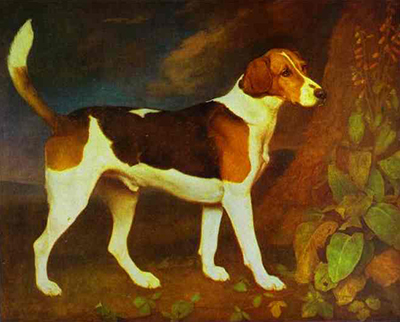Had George Stubbs lived today, he would almost certainly have been a photographer. His detailed studies of various exotic animals were, at the time, the first and sometimes only glimpse of these creatures that the people of England ever had.
He believed that nature always outweighed the man-made, even travelling through Italy to view the architecture in an effort to prove or disprove his theory. Satisfied that he was correct, he returned to England and turned his attention to anatomical studies, dissecting horses and dogs amongst other animals. In his later years, he turned his skills towards anatomical comparisons, with a set of etchings remaining uncompleted at the time of his death. However, in his heyday, Stubbs produced immaculate and accurately detailed paintings of animals, especially horses, but often including or featuring dogs too. This image, entitled A Foxhound Called Ringwood, or sometimes Ringwood, a Brocklesby Foxhound was painted in 1792.
The image depicts a single foxhound, highlighted by low sunlight such as that seen during the golden hour at sunset. The dog is picked out in exquisite detail, with the light playing off his muscles and glossy healthy coat. Stubbs was so expert in anatomy by this time that the viewer can almost see the muscles bulging under the skin and the tendons poised for action, springy and vibrant. The dog's attention is drawn to something out of sight of the viewer, his ears raised alertly as he looks out of frame. The tree trunk against which the dog is posed, and the moody dark background combine to make the dog's tri-colour coat – typical of foxhounds – pop, drawing the gaze of the viewer.
As mentioned above, Stubbs would have embraced the camera with joy, delighting in being able to capture life-like representations of his beloved natural scenes in mere minutes or even seconds. But this is not to detract from Stubbs' tremendous skill at painting: not only could he faithfully render an accurate and vividly life-like image of an animal – or human, he was also skilled at human portraiture – he was skilled at portraying the character of his subjects and a sense of the atmosphere of the surroundings too.




